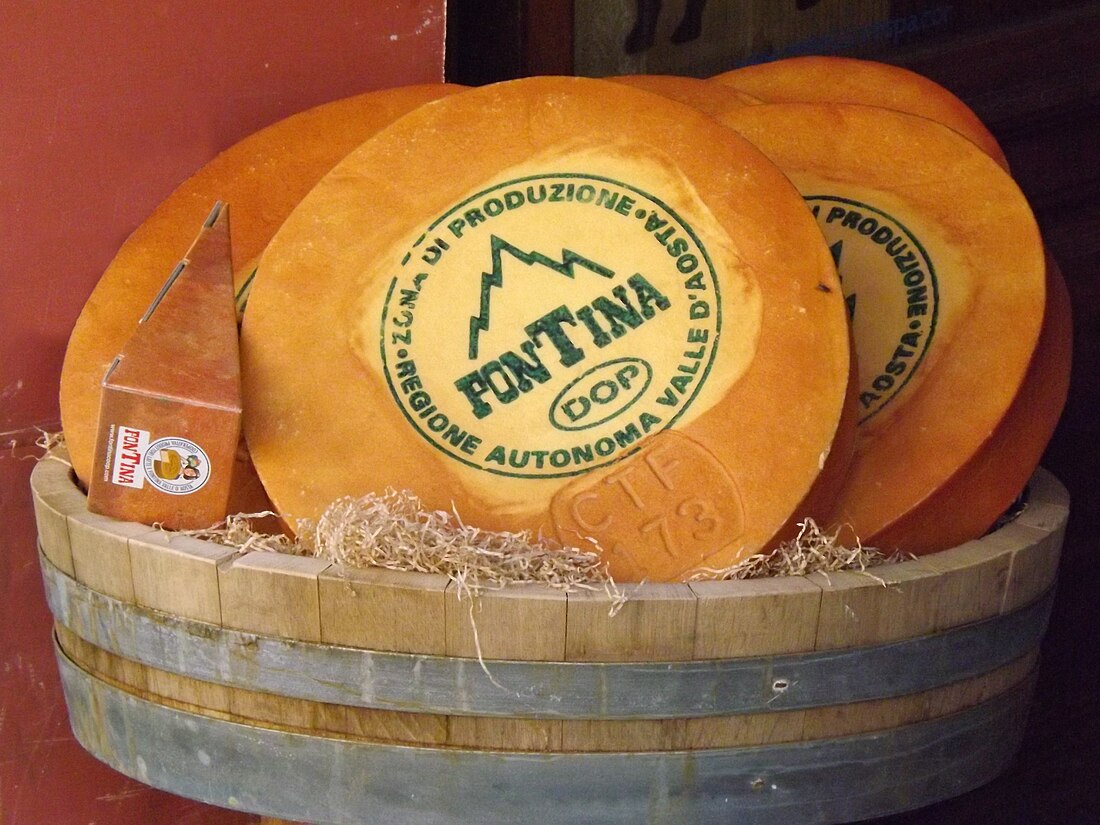Top Qs
Timeline
Chat
Perspective
Fontina
Italian cheese From Wikipedia, the free encyclopedia
Remove ads
Fontina (French: fontine[1]) is a cow's milk cheese, first produced in Italy. Over time, production of fontina has spread worldwide, including to the United States, Denmark, Sweden, Canada, France, and Argentina.[2][3]
Remove ads
Description
Summarize
Perspective
Fontina is a cheese that is semisoft to hard in texture and mild to medium-sharp in flavor. It has a milk fat content around 45%. The characteristic flavor of fontina is creamy and mild but distinctively savoury and nutty, the nuttiness increasing with aging. Fontinas from Sweden, Denmark, and the United States have milder flavor, softer texture, and more holes than those of Italy.
Fontina cheese has been made in the Aosta Valley, in the Alps, since the 12th century. Fontina produced in the EU can be identified by a consortium stamp of the Matterhorn including the script "FONTINA".[4][5]
As with many other varieties, the name "fontina" has derivatives such as "fontinella", "fontal", and "fontella".[6] Although the version from the Aosta Valley is the original and the most famous,[7] a derivative production occurs in other parts of Italy, as well as in Denmark, Sweden, Quebec, France, Argentina, and the United States.[8]
Fontina produced in the Aosta Valley has a protected designation of origin, with regulations that it must be made from unpasteurized milk from a single milking, with two batches being made per day.[9]

Aostan fontina has a natural rind due to aging, which is usually tan to orange-brown.[10][11] The interior of the cheese is pale cream in color and riddled with holes known as "eyes".[12] It is noted for its earthy, mushroomy, and woody taste, and pairs exceptionally well with roast meats and truffles.[13]
Terroir and flavour
The distinct flavour of Fontina from Aosta Valley is intrinsically linked to the concept of terroir, reflecting the unique botanical diversity of the high-altitude alpine pastures where the Valdostana cows graze. The milk's quality is influenced by the rich flora, which includes hundreds of different plant species.
Among these species, Alpine clover (Trifolium alpinum) is particularly significant. An ethnobotanical study in the Aosta Valley documented the traditional knowledge that T. alpinum is an excellent fodder that "makes milk fatter and fontina cheese delicious".[14] This belief is supported by scientific analysis. Studies on traditional semi-hard cheeses from the region have shown that milk from cows grazing on pastures dominated by Trifolium alpinum produces cheese with a distinct chemical profile. These cheeses contain reliable biomarkers, including higher levels of specific odd-chain fatty acids and a unique hydrocarbon ratio, that directly link them to the clover-rich diet.[15] Additionally, the plant's potent fragrance, derived from a complex blend of volatile organic compounds, is transferred from the forage to the milk, contributing to the unique aroma of the final cheese.[16]
Remove ads
Recipes
Young fontina has a softer texture and can be suitable for fondue. Fonduta alla valdostana (in Italian) or Fondue à la valdôtaine[17] (in French) is a traditional dish of fontina whipped with milk, eggs, and truffles. Mature fontina is a hard cheese, and still melts well.
A good pairing is Nebbiolo, a red wine with flavors of wild cherry and truffles.[12]
Generic nature of fontina
In 1986, the U.S. Trademark Trial and Appeal Board ruled that "fontina" was the generic name of a type of cheese "rather than a certification mark indicating regional origin, in view of the fact that non-certified producers outside that region use the term to identify non-certified cheeses". Today, fontina is produced in countries around the world, including the United States, Denmark, Sweden, Quebec, France, and Argentina.[18]
See also
References
External links
Wikiwand - on
Seamless Wikipedia browsing. On steroids.
Remove ads

